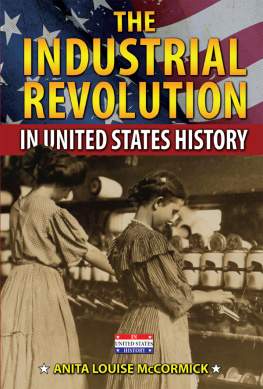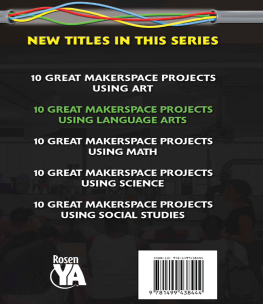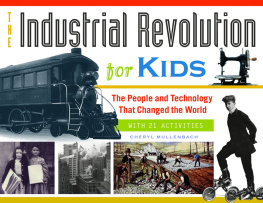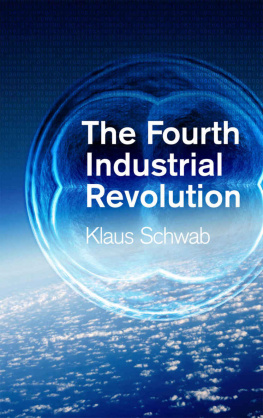Amazing Inventions
Imagine listening as Alexander Graham Bell demonstrates his new inventionthe telephoneor watching Thomas Edison as he shows off his latest inventionthe automatic telegraph. At the 1876 Centennial Exhibition, celebrating the one hundredth anniversary of America's independence, fair-goers were constantly amazed at these and other inventions that would make life easier for them and for every American.
In The Industrial Revolution in United States History, author Anita Louise McCormick traces the development of American industry from its roots in eighteenth-century England through its decline around the time of World War II. From the steam engine to the telegraph to the motion picture industry, McCormick shows how, in less than two hundred years, the Industrial Revolution was able to transform the United States from an agricultural country of small farmers to the richest and most powerful industrial nation in the world.
"A thoroughly detailed account"
ALMA
"The writing is succinct and accurate"
Bayviews
ABOUT THE AUTHOR
Anita Louise McCormick has written several books and articles on a wide variety of issues and events. Among her other books for Enslow Publishers, Inc., is Native Americans and the Reservation in American History.


Image Credit: Library of Congress
A young girl working as a spinner at the Rhodes Manufacturing Company in Lincolnton, North Carolina, gets a momentary glimpse at the world outside.
May 10, 1876, was an exciting day in Philadelphia. It was the opening day of the Centennial Exhibitionthe first worlds fair ever to be held in the United States.
Thousands of people from all walks of life came to Philadelphias Fairmount Park to take part in the celebration. Politicians, scientists, inventors, writers, artisans, and housewives crowded in through the gates. Dignitaries from many nations were there. The exhibitors, especially a group of American inventors who had worked for years to perfect their ideas and bring them into the marketplace, were anxious to show their work to all who came.
The Centennial Exhibition was billed as the greatest spectacle ever presented to the vision of the Western World.,
Items from every American state, as well as fifty foreign nations, were on display. Even countries as far away as China and Egypt participated. There was fine silk from the Far East, hand-carved furniture from Europe, and fancy china and pottery. In short, the fair showcased the best the world had to offer in the fields of art, science, and commerce. But among the most popular attractions at the 1876 Centennial Exhibition were the exhibits of technological innovationall new products of the Industrial Revolution.
Machinery Hall, a building that covered nearly twenty acres of the fairground, held the bulk of these new inventions. Fairgoers passing through the large hall could hardly believe what they saw. They marveled at gas stoves, typewriters, mimeograph machines, and many other inventions for the home and office that had recently come out on the market.
New kinds of industrial and agricultural equipment were also on display. There were machines for making everything from factory equipment to consumer goods such as shoes, envelopes, wallpaper, and cloth.
Among all the unique and diverse inventions, one machine in particular caught everyones eye. It was the largest steam engine ever builta thirty-foot monster that held the attention of everyone in the hall.
George Corliss stood at the base of the huge twenty-five hundred horsepower engine he had created. At his side stood Americas president, Ulysses S. Grant, and the emperor of Brazil, Dom Pedro.
Are you both ready? Corliss asked. Both national leaders nodded their heads. Then your Majesty will turn that handle.
As Emperor Pedro moved the handle, a loud hiss of steam escaped from the engine.
Now, Mr. President, yours, Corliss said.
President Grant turned the second handle as Corliss requested, allowing another loud hiss of steam to escape. Then the engines large metal beams slowly began to move and the gigantic machine went into full operation.
The crowd cheered wildly. Nearly everyone was surprised by the volume of this mighty engines rumbling, hissing, and chugging. They had never seen such a powerful machine before.
But this monster of steel, brass, and copper did much more than make noise and attract attention. It had the power to drive every steam-powered machine in the building. As soon as it was turned on, it provided the energy necessary to spin cotton, saw logs, pump water, make shoes, print newspapers, manufacture envelopes, and perform hundreds of other tasks. The fairgoers were astounded.
Although the majority of inventions at Machinery Hall were not nearly as large as George Corlisss engine, some proved, in time, to be even more impressive. Alexander Graham Bell, an inventor who was working to find new ways to communicate by using electricity, attended the Centennial Exhibition. He brought a working model of his recently patented telephone to display.
When Emperor Dom Pedro saw the invention, he immediately wanted to try it. He picked up the telephone and held it to his ear. The emperor was so startled when he heard a voice come through the speaker that he dropped the telephone and exclaimed, My God, it talks!
Thomas Alva Edison, another outstanding inventor of the late 1800s, also attended the Centennial Exhibition. Just twenty-nine years old at the time, Edison had recently begun building his now-famous laboratory in Menlo Park, New Jersey. His innovative work with electronics, which would help extend and improve communications throughout the world, was just starting to receive the recognition it deserved.
Edison brought two new telegraph machines that he had recently invented to the 1876 worlds fair. The first of these was a quadruplex telegraph. It allowed four telegraph messages to be transmitted over a single line simultaneously. The other was an automatic telegraph machine. It could read and interpret letters and numbers that had been punched into a long strip of paper tape, then transmit the desired message over a wire. The automatic telegraph could send messages six times faster than the best human telegraph operators of the time.
The magnificent displays at the Centennial Exhibition clearly demonstrated the progress that America had made in its first hundred years of independence. While the fair was billed as a celebration of Americas accomplishments of the past century, it was much more than that. It proved to the world that the United States had finally arrived as a major industrial power that was ready to meet the challenges of the future.
In its first hundred years of independence, the United States had gone through many changes. Its population had increased over ten times from around 4 million in 1790 to nearly 40 million in 1870. It was no longer the mainly agricultural society it had been when the Declaration of Independence was signed in 1776. While farming was still a vital part of the American economy, the United States was quickly becoming an industrial nation. It was a nation that could not only mass-produce the products its people needed, but also produce enough surplus to export to other nations as well.
Not even the most farsighted inventors and businessmen of the late 1700s could have foreseen the dramatic changes that the Industrial Revolution would eventually bring. By 1900, it would transform the United States from an agricultural nation into one of the wealthiest industrial nations in the world.













